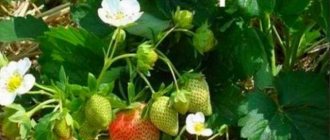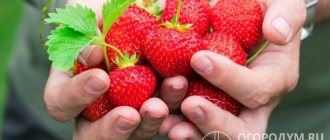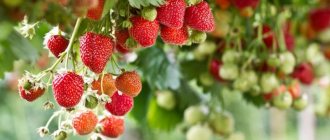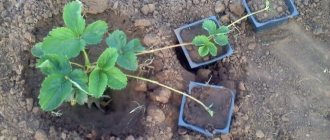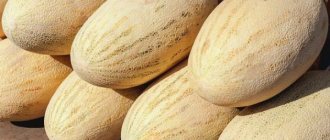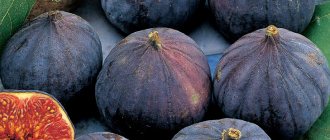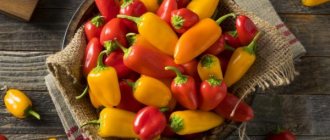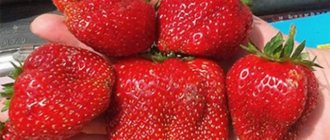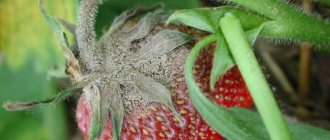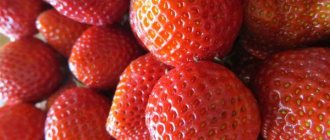Everyone loves this berry.
And if it is not only tasty, but also large, then they say it has no price. These are the qualities that distinguish the Dutch strawberry variety “Gigantella Maxim” or “Maxim”, as we also call it, which is not entirely true. After all, the real name of the variety has nothing to do with a man’s name. It would be more correct to call it “Gigantella Maximum.” Dear readers!
For you, we have created communities on social networks in which useful articles and interesting ideas are published several times a day! Subscribe and receive useful content in a convenient format! But such a change in the name in no way affected the taste and size of the fruits of this plant, which is attracting more and more adherents to its cultivation.
Description of the variety “Gigantella Maxim”
This variety of strawberries (strawberries) is characterized by a medium-late ripening period . Its fruits are juicy, sweet with a subtle strawberry aroma, which gives it a unique taste. It is because of this that many gardeners call the plant “Maxim” garden strawberry.
Important! This variety is loved by gardeners for its frost resistance. True, in very harsh weather conditions the plant requires shelter for the winter.
Bushes
They are very large, have a height of 35-50 cm, in the second or third year of cultivation they reach a diameter of 60-70 cm. And the slightly large, unlike other varieties of berries, corrugated leaves make them lush.
The rhizome of “Gigantella” also differs in size, in addition, it is also quite powerful. Therefore, this variety of strawberries does not like dense planting .
Flowers and berries
Numerous flower stalks of the plant, of which there are 20-30 pieces on the bush, are thick, elastic, during flowering with 6-8 flowers on each, are able to hold the berries well and do not allow them to touch the ground.
Strawberries begin to bloom quite early - in May, so they can please you with their berries at the end of this month or at the beginning of June. It is the speed of formation and ripening of the crop that is one of the main advantages of the plant, which pleases with its fruits for almost two weeks.
The first berries are quite large - about 100-125, with further ripening they become slightly smaller - 40-60 grams.
In cross section they are up to 9-10 mm. Of course, they reach such sizes (a small apple or apricot) with proper cultivation.
The color of the berries is dark red, dense with a rough surface. But their core, if not watered enough, can be hollow and taste dry. But this does not spoil the taste of Maxim at all.
Interesting! Berries lend themselves well to freezing without losing their taste. Therefore, many strawberry lovers use this method of preserving them for the winter.
Strawberry yield
"Gigantella Maxim" is a high-yielding variety of strawberry. With proper cultivation techniques and regular watering, up to 2.5 kg of berries are harvested from one bush.
In order for the plant to bear fruit well, experienced gardeners recommend regularly removing shoots and tendrils from the bushes, as well as ridding the area of weeds.
Although Gigantella bushes can grow in one place for up to 7 years, the beds with its plantings should still be updated every three years.
Transportability
This strawberry is often grown for commercial purposes, since its berries are very dense and tolerate transportation well without losing their presentation.
Productivity
Gigantella Maxi is famous for its high yield. From one bush you can get about 2 kg of fruit. And with certain efforts - all 3 kg. The harvest on the bushes may appear as early as a year after planting, however, it will be meager. Therefore, it is recommended to pick off the flowers during the first flowering to give the plant the opportunity to gain strength for the next season.
Timely cutting of the mustache also contributes to increasing productivity.
Photo of the variety
Advantages
As you can see, the “Gigantella Maxim” strawberry has many advantages in order to pay attention to it and start growing it:
- unusually large sizes of fruits that grow on bushes regardless of their age;
- constantly stable yield with proper care;
- long-term preservation of the presentation of the harvested crop, the attractive appearance of the berries and the possibility of transporting them without much loss;
- quite pleasant taste;
- the possibility of preserving for the winter by freezing without loss of taste and quality;
- quite a long ripening period.
Strawberry "Gigantella Maxim"
In fact, this is just another variant of the name of the variety, which is a variety or is a direct descendant of the same “Gigantella”. Accordingly, it has similar characteristics and properties.
Photos from sites offering planting material for strawberries of the Gigantella Maxim variety
Nowadays the strawberry variety “Maxim” (“Gigantella Maxim”) is promoted primarily for amateur cultivation.
When purchasing planting material, you need to understand that the risk of misgrading is very high and under the guise of “Maxim” (as well as other actively advertised, but not registered varieties with tempting names), any degenerate clones of large-fruited (also not a fact) varieties of strawberries can be offered.
Let's move on to a detailed description of the properties, advantages and disadvantages of the Maxim strawberry variety.
Flaws
Of course, despite many advantages, this variety cannot be called completely ideal. Among the disadvantages of Maxim it should be noted:
- moisture dependence - if there is insufficient watering, the fruits do not set well and the plant withers, so in the area with these strawberries it is good to use drip irrigation;
- demanding in choosing a site - does not tolerate shading well (it does not ripen, and in rainy weather it is affected by gray rot), does not accept the sun at all, but is very light-loving;
- pretentiousness to the composition of the soil - the area for it is best allocated on rested soil, a place where legume green manure was cultivated;
- renewal is mandatory - to obtain a consistently high yield, the bushes should be rejuvenated every three years; if this is not done, then in subsequent years the berries will begin to noticeably become smaller, deformed, and the plant itself will become sick.
But that's probably all. Otherwise, the variety is avant-garde and worthy of attention.
Reviews from gardeners
If you follow our recommendations, Maxim strawberries will look like in the photo.
Most reviews from gardeners who grow this variety in their gardens are positive.
They all note the excellent taste of the berries, coupled with their size. They add that care and planting do not require any labor-intensive actions or financial costs.
Strawberries reproduce well, thanks to their high yield, and are resistant to diseases and low temperatures. And yet, its productivity is directly related to the quality of agricultural work carried out, so better care gives better results.
Planting and propagation
When cultivating this plant, you should never forget how big it grows. Therefore, when planting strawberries of the “Maxim” variety, they adhere to a density of four plants per square meter.
You should be especially careful when choosing a site for this strawberry. After all, proper preparation is the key to the level and duration of its fruiting, and quality indicators of productivity.
Important! When planting strawberry bushes of this variety, their roots should be cut to 1 cm. This is done in order to ensure that the roots are vertical when planting.
As for the propagation of the variety, it is traditional - by seeds, seedlings grown from the mustache, and by dividing the bush.
Planting by seeds
When propagating by seeds, you should know that strawberries obtained using this method of propagation will bloom only in the third year.
Seeds should be sown in February in shallow containers with drainage, into which a mixture of soil and sand (2:1) is poured.
The seed material is scattered not too thickly over its surface, which is then moistened with a sprayer. Then this container is covered with film or glass and placed in a bright and warm place.
Shoots usually appear after 14 days. Further, the agricultural technology for growing seedlings is no different from the generally accepted procedure for growing strawberries from seeds.
Landing with a mustache
Everyone knows that almost every adult strawberry bush grows mustaches during the growing season. So they are used to propagate berries. To do this, you should choose antennae with a strong, well-developed rosette. It is they who are separated from the mother bush and transplanted to the place where it will already develop as an independent plant.
Therefore, during the fruiting period, mark the most fruit-bearing strawberry bushes. And then take layering from them. They need to be planted in small pots, from which, after rooting, the seedlings, together with a lump of earth, can easily be transferred into the holes to a permanent place.
Of course, with this method of propagation in the first year the harvest will be quite modest, but you will not have to spend money on purchasing seedlings.
Reproduction by dividing the bush
Planting material can also be obtained by separating mother plants.
At the same time, it is immediately ready for planting. Plants 3-4 years old are suitable for this purpose. The main disadvantage of this method of propagation is the long period of adaptation of the seedling.
To somehow improve it, you should plant the separated bushes in a nutritious soil mixture consisting of garden soil with humus and sand (2:2:1).
It often happens that a new bush begins to bear fruit in the second or even third year.
Collection and storage of berries
Maxim strawberry is a short-day crop. It bears fruit once a year, but the duration of fruiting is quite long (until August). The first fruits ripen at the end of June.
Berries should be collected gradually as they ripen. Make sure that the strawberries do not overripe on the bushes. The degree of maturity is determined by the color of the fruit. If the tops are whitish, then the berries are not ripe.
Strawberries of this variety can be consumed fresh or frozen. It also makes delicious jam, jam, and compote.
Care
In general, caring for “Maxim” provides the same rules as for other varieties of this crop. However, since this is a large-fruited variety, there are also some differences.
Thus, the Gigantella strawberry is characterized by very rapid growth, during which its bushes form many tendrils. To prevent the planting from becoming dense, they should be cut off. If you need layering for propagation, then you can leave a couple of bushes alone.
Watering strawberries
This variety requires regular watering. It is important that it is sufficient and timely. Only in this case can you get high-quality berries.
The plant is usually watered 3-4 times a week. To retain moisture, the soil around the bushes is mulched.
Strawberries especially urgently need watering during fruiting. It is good to do this in the morning before sunrise or in the evening after sunset.
In general, the optimal solution for this variety is drip irrigation. In the absence of such, the area is watered between the rows.
Important! After each watering, it is important to loosen the soil and simultaneous weeding.
Transfer
Strawberries of the Maxim variety, as mentioned above, require replanting in the fourth year of cultivation. It is optimal to carry it out in the middle of the second summer month, trying to injure the roots of the plants as little as possible.
Fertilizer and feeding
In order for this variety of strawberry to develop well and bear fruit, the plants must be fertilized and fed. So, every year it’s a good idea to add a bucket of rotted compost under the bushes. In the spring, it is recommended to treat the area with “Maxim” with a mixture of “Gumi” and “Fitosporin” to disinfect the soil.
It is necessary to feed the plants once a week , but not less often, using an infusion of organic matter. To obtain it, you should add potassium salt, superphosphate, mullein or bird droppings to the weed infusion. It is good to use complex fertilizers for garden strawberries for these purposes.
This procedure is usually combined with watering.
Caring for strawberries in the second and subsequent years
Care in the second and subsequent years should be aimed at efficiency, namely: obtaining a high yield and quality of berries. At this stage, it is important to provide the plants with adequate nutrition throughout the growing season.
Feeding during the growing season
Strawberries are very responsive to the application of organic and mineral fertilizers to the soil. Agricultural technology allows you to feed plantings up to 4 times a season:
- The first fertilizing with nitrogen-phosphorus fertilizers is carried out immediately after wintering ends and the strawberry bushes are freed from shelter. It will promote the growth of foliage and strengthen the root system. It is important not to overdo it, because an overdose of nitrogen is very dangerous. It can have the opposite effect, for example, reduce the intensity of fruit color, impair their keeping quality, or, even worse, lead to an increase in diseases.
- The second feeding must be carried out during the budding period of the plant. At this stage, the supply of potassium and calcium to the soil is important. They will not only inhibit the effect of excess nitrogen, but will also have a beneficial effect on the strength of the cell walls of future fruits, which will have a positive effect on their quality, weight, size and quantity.
- The third application of complex fertilizers during the period of berry growth will stimulate the plant to the process of uniform ripening of fruits with intense coloring in accordance with the characteristics of the variety.
- The fourth stage of mineralization occurs after the end of fruiting during the formation of flower buds for the future harvest. Phosphorus-potassium fertilizers should dominate in this process.
Nutrivant, Fertivant, Kelkat Mix, Kelik Mix will come to the rescue with problems with growing strawberries
Mineral elements and their importance for strawberries
In order to correctly distribute the load of fertilizers on a strawberry bed, you need to know the effect of the main elements of mineral nutrition.
Table: influence of mineral elements on fruiting
| Element | Signs of deficiency or excess | Consequences for strawberries | Corrective measures |
| Nitrogen |
|
|
|
| Phosphorus | Dark green leaf color with blue segments along the edges. |
| Application of phosphorus-potassium fertilizers. |
| Potassium | Brown spots on leaves. |
| Before planting the roots, apply phosphorus-potassium fertilizers. |
| Calcium |
| The fruits grow small and deformed. | Foliar and root feeding with calcium nitrate. |
| Iron, copper, zinc | Pale leaves with yellow veins. |
| Complex fertilizers:
|
| Boron, magnesium, silicon, sulfur |
|
|
Photo gallery: deviations in plant development due to a lack of mineral elements
With nitrogen deficiency, strawberry leaves and cuttings turn yellow or have blue-red tones
With a lack of boron and magnesium, the elasticity of the leaves decreases, the plant becomes vulnerable to disease. With a deficiency of iron and zinc, the leaves turn pale and become unviable
With a lack of potassium, brown spots form on the leaves, creating the preconditions for the development of brown rot
Thus, the balance of all trace minerals is very important. Without it, strawberries run the risk of fungal and viral diseases.
Video: caring for a strawberry bed
Diseases and pests
The strawberry variety “Gigantella Maxim” is attractive not only to gardeners, but also to all kinds of pests.
To prevent various insects and fungal diseases from appearing on the site, the bushes must be treated on time.
In general, about four sprays per season are enough to get rid of all this evil. To do this, use a mixture of the same drugs “Fitosporin” and “Gumi”.
True, during the budding period they also add 5 drops of Fitoverma. Treatment of plants is carried out in early May, during plant budding, in early August and in September.

